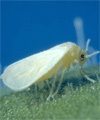April
Whitefly confused by cacophony of smells

Bombarding pests with smells from many different plants temporarily confuses them and hinders their ability to feed, new research has shown.
Biologists at Newcastle University, UK, have been exploring the potential of harmless plant volatiles as an alternative to pesticides in greenhouses.
Testing a phenomenon known as the ‘confusion effect’ – whereby animals and humans become inefficient at a task when they are bombarded with lots of distracting information – the team pumped a mixture of plant smells into a greenhouse growing tomato plants.
Exposing the whitefly to a heady aroma of cucumber, courgette, watercress, watermelon, cabbage and bean, the team found the insects became temporarily disorientated.
Like other insect pests, whitefly feed by pushing their long mouthpiece – or stylets – into the leaf until it reaches the plant’s main source of nutrients travelling through the phloem. Weaving their way between the plant cells to reach the sap is technically challenging and the team found the whiteflies failed to feed while they were being bombarded with the different plant chemicals.
Publishing their findings this week in the academic journal Agronomy for Sustainable Development, research leads Dr Colin Tosh and Dr Barry Brogan said this method of control could be an important step towards a more sustainable method of pest control.
“It’s like trying to concentrate on work while the TV’s on and the radio’s blaring out and someone’s talking to you,” explains Dr Tosh, based in Newcastle University’s
School of Biology. “You can’t do it – or at least not properly or efficiently – and it’s the same for the whitefly.
“Whiteflies use their sense of smell to locate tomato plants. By bombarding its senses with a range of different smells we create ‘sensory confusion’ and the result is that the insect becomes disorientated and is unable to feed.
“Because the effect is temporary – we saw it last no more than 15 hours – it’s unlikely this method alone could be used to control crop pests. But this is an easy and safe way of buying the plants time until their own chemical defence mechanisms kick in. Used in conjunction with other methods, sensory confusion opens up a whole new area in sustainable pest control.”
Trialeurodes vaporariorum – or whitefly – is a major worldwide pest of greenhouse crops and is traditionally controlled using chemical pesticides or biological methods such as parasites.
Previous studies have shown that whitefly become ‘restless’ when a number of plant species are mixed together rather than being exposed to a single crop. The aim of this latest research, funded by the Natural Environment Research Council (NERC), was to artificially create this mixed environment for a single crop greenhouse.
Measuring the time it took from the insect settling on a plant to accessing the plant sap, the team showed that hardly any of the whiteflies exposed to a range of smells started feeding from the phloem within 15 hours from the time of exposure. By comparison, the majority of whiteflies exposed to just the single smell released by the tomato plants started feeding within this time.
Dr Brogan, also based in the School of Biology, adds: “Plants talk to each other when they are under attack – producing chemicals which warn other plants close by of the threat. At the same time, they produce a chemical which is unpleasant to the predator.
“But this response doesn’t happen immediately, so if we can confuse the insects long enough to give the plants time to defend themselves this may go some way to reducing crop losses.”
The team have now started the next phase of the study to investigate ways of helping plants to talk to each other and better switch on their defences.
Source Information: “Control of tomato whiteflies using the confusion effect of plant odours”. Colin Tosh and Barry Brogan. Agronomy for Sustainable Development. DOI 10.1007/s13593-014-0219-4
published on: 28 April 2014
